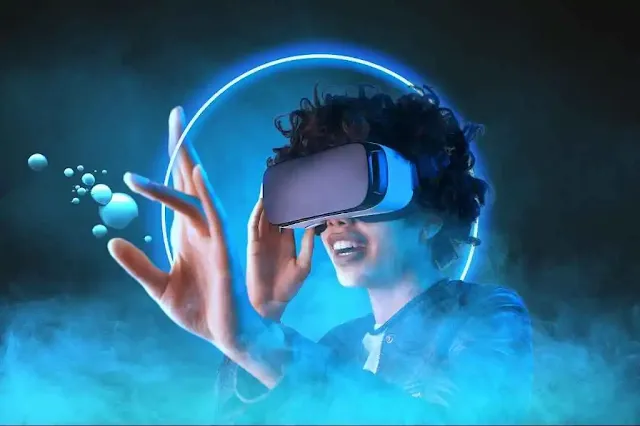A Comprehensive Guide to the Future of Digital Interaction
The Metaverse is no longer a sci-fi fantasy—it’s a rapidly evolving digital universe blending augmented reality (AR), virtual reality (VR), blockchain, and AI. By 2025, it’s projected to become a $5 trillion market, redefining how we work, socialize, and play. This article explores the Metaverse’s core concepts, key players, technological underpinnings, and societal impacts, offering actionable insights for beginners, professionals, developers, and tech enthusiasts.
 |
| Metaverse Explained: The Next Big Thing in Tech |
Key Terms Simplified
1.1 What is the Metaverse?
- Definition: A persistent, interconnected 3D virtual space where users interact via avatars.
- Analogy: Imagine the internet as a 3D world you “step into” using VR glasses.
1.2 Core Technologies
- VR/AR: Devices like Meta Quest 3 or Apple Vision Pro enable immersive experiences.
- Blockchain: Powers ownership of digital assets (NFTs) via decentralized ledgers.
- Digital Twins: Virtual replicas of real-world objects (e.g., factories, cities).
2. The Metaverse Ecosystem: Key Players & Trends
2.1 Market Leaders
| Company | Focus Area | Key Product |
|---|---|---|
| Meta | Social VR | Horizon Worlds |
| Microsoft | Enterprise Metaverse | Mesh for Teams |
| Decentraland | Blockchain-Based Worlds | MANA cryptocurrency |
| Epic Games | Gaming & Entertainment | Fortnite Creative 2.0 |
2.2 Top Metaverse Trends in 2025
Trend 1: Virtual Commerce
Case Study: Nike’s .SWOOSH Platform
- Nike sells virtual sneakers as NFTs, earning $200M in 2024. Users “wear” them in games like Fortnite.
- Tech Behind It: Ethereum blockchain ensures authenticity and ownership.
Trend 2: Remote Work Revolution
Case Study: Accenture’s Nth Floor
- Accenture onboarded 150,000 employees in a virtual office, cutting training costs by 40%.
- Tools Used: VR headsets, spatial audio, and haptic feedback gloves.
Trend 3: Healthcare Innovation
Case Study: Johns Hopkins Virtual Surgery
Surgeons practice complex procedures in VR, reducing error rates by 30%.
3. Building the Metaverse: Technologies Explained
3.1 Blockchain & NFTs
How NFTs Work
1-Minting: An asset (art, music) is tokenized on a blockchain.
2-Ownership: Tracked via smart contracts (e.g., Ethereum’s ERC-721).
3-Trading: Sold on marketplaces like OpenSea.
2-Ownership: Tracked via smart contracts (e.g., Ethereum’s ERC-721).
3-Trading: Sold on marketplaces like OpenSea.
Example: Beeple’s NFT art sold for $69M, showcasing the Metaverse’s economic potential.
3.2 VR/AR Hardware
| Device | Key Feature | Price | Best For |
|---|---|---|---|
| Meta Quest 3 | Mixed reality passthrough | $499 | Gaming & Social |
| Apple Vision Pro | 4K micro-OLED displays | $3,499 | Professional Use |
| HTC Vive XR Elite | Full-color AR mode | $1,099 | Enterprise Training |
3.3 Interoperability Challenges
- Problem: Metaverse platforms (e.g., Decentraland, Sandbox) operate in silos.
- Solution: Open Metaverse Alliance promotes cross-platform standards for avatars and assets.
4. Industry-Specific Applications
4.1 Retail: Virtual Storefronts
- Case Study: Gucci’s Roblox Store
Sold a virtual handbag for $4,115 (more than the physical version).
- Tech Stack: Roblox Studio, Unity, blockchain for limited editions.
4.3 Real Estate: Virtual Land Boom
- Case Study: Republic Realm
Developed a virtual mall in Decentraland, generating $2.4M in annual rent.
- Data: Average virtual land price rose from 15,000 (2025)**
5. Technical Challenges & Solutions
5.1 Latency & Bandwidth
- Issue: VR requires <20 ms latency to prevent motion sickness.
- Solution: 5G edge computing reduces latency to 5 ms (Verizon, 2024).
5.2 Privacy & Security
- Threats: Data breaches, deepfakes.
- Solutions:
Zero-Knowledge Proofs: Verify identity without exposing data.
Decentralized IDs (DIDs): Users control their data via blockchain.
6. The Future of the Metaverse: 2030 Predictions
1-Ubiquitous AR Glasses: Apple’s Vision Pro 3 will replace smartphones.
2-AI-Generated Worlds: Tools like OpenAI’s GPT-5 will auto-create 3D environments.
3-Regulatory Frameworks: Governments will tax virtual transactions (EU’s Metaverse Tax Directive).
7. FAQs (Featured Snippets)
Q: What is the Metaverse?
A: A shared virtual space where users interact via avatars, powered by VR, AR, and blockchain.
Q: How do I invest in the Metaverse?
A: Buy virtual land (Decentraland), Metaverse ETFs (Roundhill Ball Metaverse), or NFTs.
Q: Is the Metaverse safe for kids?
A: Risks include privacy breaches. Use platforms with COPPA compliance like Roblox.
Conclusion
The Metaverse is redefining human interaction, blending physical and digital realms. From virtual workplaces to NFT marketplaces, its potential is limitless—but challenges like interoperability and privacy remain. As AI and 5G advance, the Metaverse will become as integral as the internet. The future is virtual, and it’s here.
Poll: "Which Metaverse application excites you most? (A) Gaming (B) Virtual Work (C) NFTs."
التسميات
Tech Trends
